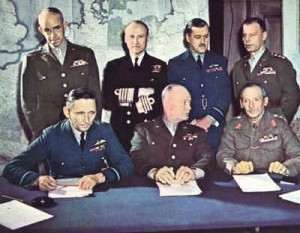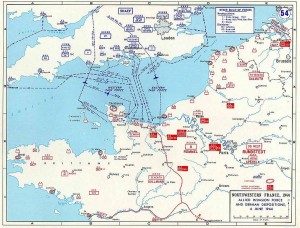
On June 6, 1944, forevermore remembered as D-Day, Allied forces under the command of future American President Dwight D. Eisenhower landed on the beaches of Normandy. This successful action signaled the beginning of the end of the Second World War: it was the first stage in the liberation of Western Europe and a major step towards the defeat of Nazi Germany. The campaign was code-named Operation Overlord.
 By the first week of June 1944, Nazi Germany controlled most of Western Europe. Allied forces, numbering over 156,000, were poised to travel by ship or plane over the English Channel to attack the German army dug in at Normandy, France. Eisenhower had a window of only four days of decent weather in which an invasion would be possible. When bad weather hit the channel on June 4, Eisenhower wrestled with the idea of postponing Operation Overlord. Weather conditions were predicted to worsen over the next two weeks and he had thousands of personnel and thousands of tons of supplies that were in his words, “hanging on the end of a limb.” After a promising but cautious report from his meteorologist at 9:45 p.m. on June 5, Eisenhower told his staff “let’s go.”
By the first week of June 1944, Nazi Germany controlled most of Western Europe. Allied forces, numbering over 156,000, were poised to travel by ship or plane over the English Channel to attack the German army dug in at Normandy, France. Eisenhower had a window of only four days of decent weather in which an invasion would be possible. When bad weather hit the channel on June 4, Eisenhower wrestled with the idea of postponing Operation Overlord. Weather conditions were predicted to worsen over the next two weeks and he had thousands of personnel and thousands of tons of supplies that were in his words, “hanging on the end of a limb.” After a promising but cautious report from his meteorologist at 9:45 p.m. on June 5, Eisenhower told his staff “let’s go.”
The planning and logistics behind Overlord were unparalleled in history. The Allies had to ensure that none of the plan was released – above all, the desire to fool the Germans that the Pas de Calais was the main target as opposed to Normandy.
The mere gathering of equipment needed for the invasion was an issue in itself. Where could it be stored without attracting the attention of German spies? How could it be transported to selected places in the south without local people talking about it? How could the thousands of vessels needed for the invasion be gathered together and readied?
For the actual invasion, 6,000 ships were needed for D-Day and for future cross-Channel trips carrying troops and equipment. In the first three days of the attack, Overlord planned to move over 100,000 men and nearly 13,000 vehicles. The plan also included the movement of an artificial harbor so that people and materials could be landed with more ease once the landing beaches had been secured.
Overlord had built into it the movement of a total of 3 million men in 47 divisions, moved by 6000 ships with aerial cover provided by 5000 fighter planes. That it was such an overwhelming success (with major casualties only occurring at Juno and Omaha Beach) is indicative of how well planned it was.
On June 8, 1944, Supreme Allied Commander Eisenhower was able to report that the Allies had made a harrowing and deadly, but ultimately successful, landing on the beaches of Normandy.
The cost of the Normandy campaign was horrific. From D-Day to August 21, the Allies had landed 2,052,299 men in northern France. There were 209,672 Alllied casualties. 36,976 killed, 153,475 wounded and 19,221 missing.
We remember the brave men and women that participated in Operation Overlord today.
 ***Ed Randazzo, is a nationally syndicated author. He has been a conservative activist and consultant for over 30 years and is currently the Chief News Editor of Life and Liberty Media and Co-Producer of Liberty Today, a weekly television program seen on cable systems in most of South Dakota***
***Ed Randazzo, is a nationally syndicated author. He has been a conservative activist and consultant for over 30 years and is currently the Chief News Editor of Life and Liberty Media and Co-Producer of Liberty Today, a weekly television program seen on cable systems in most of South Dakota***
 By the first week of June 1944, Nazi Germany controlled most of Western Europe. Allied forces, numbering over 156,000, were poised to travel by ship or plane over the English Channel to attack the German army dug in at Normandy, France. Eisenhower had a window of only four days of decent weather in which an invasion would be possible. When bad weather hit the channel on June 4, Eisenhower wrestled with the idea of postponing Operation Overlord. Weather conditions were predicted to worsen over the next two weeks and he had thousands of personnel and thousands of tons of supplies that were in his words, “hanging on the end of a limb.” After a promising but cautious report from his meteorologist at 9:45 p.m. on June 5, Eisenhower told his staff “let’s go.”
By the first week of June 1944, Nazi Germany controlled most of Western Europe. Allied forces, numbering over 156,000, were poised to travel by ship or plane over the English Channel to attack the German army dug in at Normandy, France. Eisenhower had a window of only four days of decent weather in which an invasion would be possible. When bad weather hit the channel on June 4, Eisenhower wrestled with the idea of postponing Operation Overlord. Weather conditions were predicted to worsen over the next two weeks and he had thousands of personnel and thousands of tons of supplies that were in his words, “hanging on the end of a limb.” After a promising but cautious report from his meteorologist at 9:45 p.m. on June 5, Eisenhower told his staff “let’s go.”


